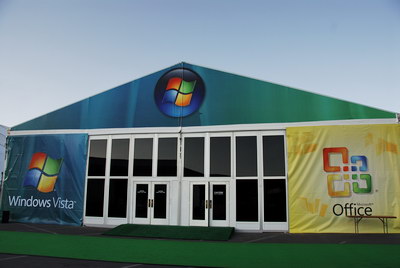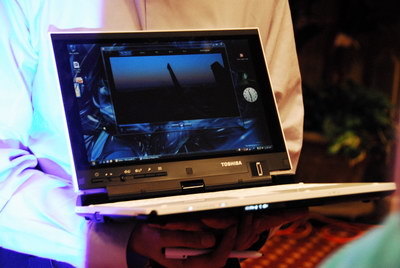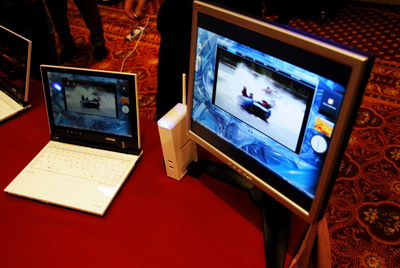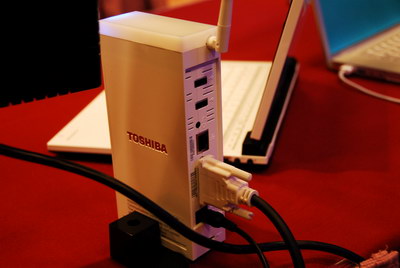Monday, January 15, 2007
Windows Vista Lab 2007: Day Two
Posted by Jason Dunn in "THOUGHT" @ 08:00 AM

Figure 1: The Microsoft Vista Partner Pavilion.
Just before we left, something very cool happened: Bill Gates, The Man himself, came into the tent for his own round of demos. He gave an impromptu talk, answering all sorts of questions. We've been asked not to go into details about what he discussed, but I will say that he's razor sharp and still very much deep into the technical realm of things - I honestly wasn't sure if he had lost his "geek chops" having been in management at Microsoft for so long, but he impressed me. Go Bill!
Session 1: Toshiba and the R400
Toshiba introduced us to their new laptop, the R400, a new product that breaks some new ground. The three main innovations on this laptop are the active notification of 3G-based email (when the laptop is closed and in a suspended state), the Toshiba Edge OLED single line external display, and the wireless video DVI-D connection to the docking station.

Figure 2: The very slender Toshiba R400.
The presenter explained the concept of active notifications that allow you to access email, real-time. It's built upon Windows Sideshow technology, and has three notification modes: Pull Mode (user driven), Direct Push mode (which seems to use an Exchange ActiveSync-type technology, the hard drive spins up and replicates the received data into Outlook), and No Wake Mode. The R400 will have an integrated EVDO card, and be paired with Verizon.
The front edge of the laptop has the display has three buttons: one to turn the notification on of off, a button that turns from the first up to the tenth email, and a button that scrolls through your calendar events. The screen is certainly tiny – I'd estimate no more than 40 characters of text can be fit on the screen at once. Still, it's enough to give you basic information.
Toshiba EasyGuard technology is a combination of hardware and software features designed for mobile workers. He said that in the London area there were 5000 notebooks left in taxi cabs last year – users are concerned about losing the laptop itself, but ultimately the loss of data is the biggest problem. Hardware solutions such as shock protection on the whole system, an accelerometer for the hard drive (to help prevent data loss from a physical drop), a forced BIOS password, and a wireless key login were all discussed. I hadn't heard of the wireless key implemented on a laptop before, but it's an interesting concept: the user has a small dongle, on their keychain for instance, and when they walk away from the laptop it will revert to the login screen, requiring a password. That's smart security!

Figure 3: The wireless port replicator - very slick technology.
Toshiba's wireless port replicator (available in Q2) was very interesting – it's based on WiMedia (wireless USB). It supports up to 1280 x 1024 (SXGA) resolution using a wireless DVI signal. On the replicator itself, there are four USB ports, Ethernet, audio out port, and an initial authentication port (likely to create the partnership). The range on the unit is only three to four feet, which surprised me a little – I would have expected at least a ten foot range, if not more. I spoke with the Toshiba representative afterward and he explained that there's the slightest delay in the video sync between what happens on the laptop screen and what happens on the LCD monitor. I didn't notice any delay, but he said if you were to watch a DVD on the laptop and watch the same video on the LCD monitor you'd see a slight sync problem with the audio and video. I don't imagine video editors will be using this though, so I doubt this will stop many people from taking advantage of the benefits.

Figure 4: The back of the wireless port replicator showing the DVI port, Ethernet port, and two USB 2.0 ports.
In the demo they moved the laptop ten feet away from the wireless docking station and the video signal vanished from the monitor, with the monitor going into a suspended state mode just like what would happen if you unplugged the video cable from it. When they moved the laptop back into range, it saw the video signal and sprang back to life in a few seconds. Very seamless and simple to use – if all of the other connections (Ethernet, USB devices, sound) are that seamless at disconnecting and re-connecting, this could revolutionize the mobile worker office. The price point for the wireless replicator hadn't been announced, but I suspect it will carry somewhat of a price premium – this is first-generation technology. One limitation of the unit is that most of the bandwidth is being used for transmission of the video signal - so if you transfer a large file off the network, or an attached USB hard drive, you'll see degraded video performance.












